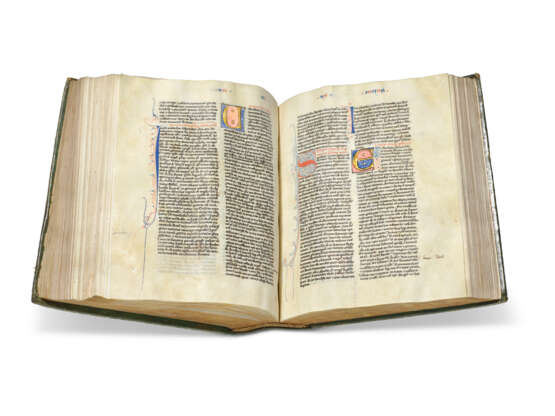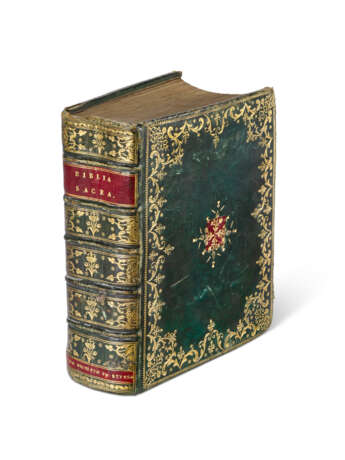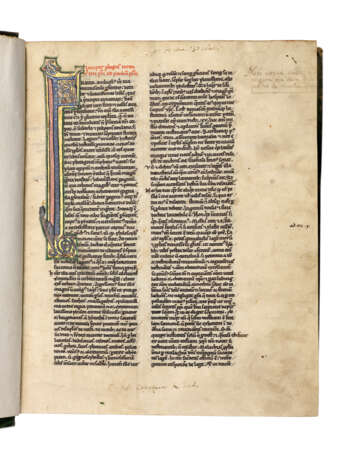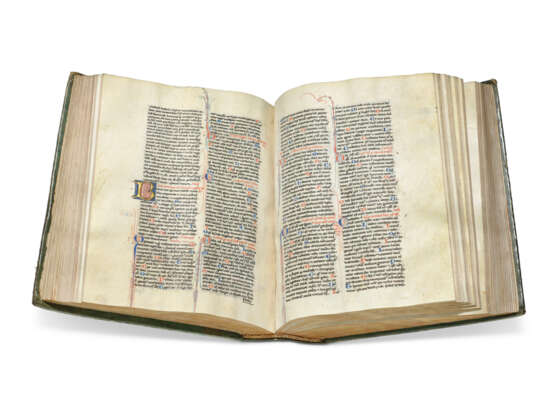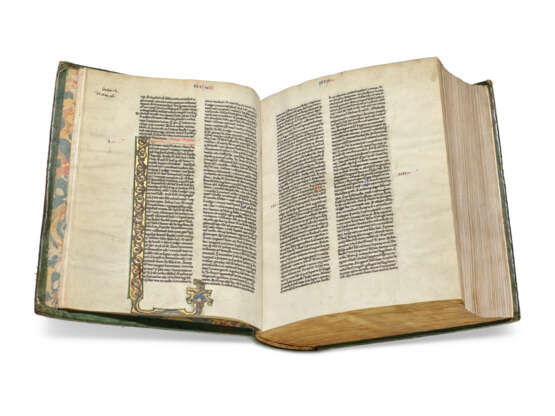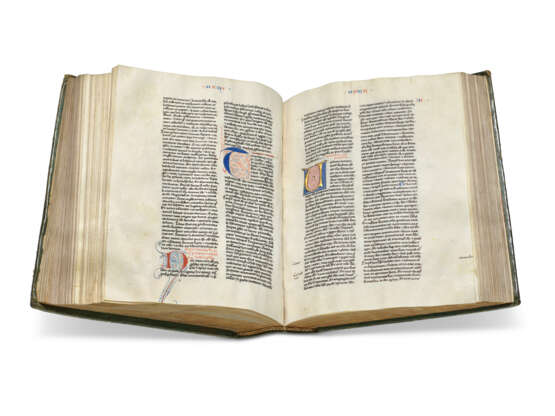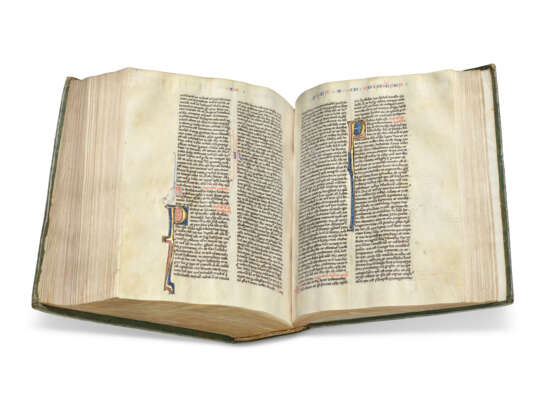ID 1214890
Лот 17 | The Vic Bible
Оценочная стоимость
£ 70 000 – 100 000
The Vic Bible, with the Prologues attributed to St Jerome and Interpretation of Hebrew Names, in Latin, illuminated manuscript on vellum [North-East Spain, mid-13th century]
An early example of a ‘Paris Bible’ copied in Spain with an illustrious and adventurous provenance.
216 x 172 mm. 433 leaves: 1-312, 411(?of 10 + i), 5-1712, 1814, 19-3612, unfoliated, two columns of 49-52 lines, ruled space: 175 x 106-114 mm, headings in read, text capitals touched yellow, one-line initials in red or blue, chapter numbers and running-titles in alternately red and blue, two- to seven-line initials in red flourished with blue, occasionally with red, or in blue flourished with red, mostly with blue, large illuminated initials in burnished gold on grounds of pink and blue patterned with white (lacking one leaf at the end of the irregular gathering 18 after f.217, lacking one gathering after f.143, between gatherings 12 and 13, and one gathering after f.241, between gatherings 20 and 21, slightly trimmed into some decoration, small pieces cut from margins ff.16 and 337, parts of margins made up with paper on seventeen leaves, smudging to some initials). Spanish 18th-century binding in green morocco gilt dentelle borders, central, presumably armorial, motif replaced by a red morocco inlay with overlapping gilt dentelle on upper and lower covers, spine in six compartments gilt, red morocco lettering pieces gilt (some wear to corners and joints, covers lightly scuffed).
Provenance:
(1) The script, decoration and text show that the Bible was copied in Spain from an early example of the ‘Paris Bible’, approaching the contents and order that evolved in Paris to a standardised form by c.1230. If written in Vic (Vich) in Catalonia, see below, the model could have been one of the books from Paris known to have been owned by Vic Cathedral in the early 13th century. Numerous neat annotations and corrections indicate ownership within a religious community.
(2) The Capuchin Convent at Vic: Capuchin de Vich in a 17th-century hand and warning in Spanish against stealing the book, which is of great worth de mucha estima[ción] f.1; ‘fra Miguel’ added f.433. The Vic Franciscan convent of the Capuchin reform was founded in 1607 and established in 1608 on the site of an early 16th-century chapel, S. Angel Custodio; the convent maintained the dedication to the Guardian Angel. In 1835, it was suppressed with all religious houses with fewer than twelve members.
(3) Joseph Bonaparte (1768-1844), made King of Spain from 1808 to 1813 by his brother Napoleon: the volume was among ten medieval manuscripts and numerous other works of art from the Spanish Royal Collections seized with Joseph’s coach and baggage train when he and the French troops fled the battlefield of Vitoria in 1813. The manuscripts had probably come from the Royal Palace in Madrid, where the bibliophile Charles IV (1788-1808) had greatly increased the library left by Charles III; he used his royal authority to collect manuscripts from a wide variety of sources, an activity that intensified from c.1800. Accounts of exactly what happened at Vitoria differ: the most dramatic has Joseph in the coach, being fired at by two aristocratic English officers, leaping out of the coach and onto a horse and so making his escape. Possibly the coach was already stranded because the French were cutting horses loose from vehicles to make their escape. Veracity was probably not helped by the fact that some of the English needed to conceal their illegal looting of Joseph’s own looting (which included Jan van Eyck’s Arnolfini Double Portrait), before order was imposed and the remaining treasures were surrendered, as legitimate booty by the rules of war, to the future Duke of Wellington, in command of the English, Spanish and Portuguese forces that had crushingly defeated the French army. Wellington’s offer in the following year to return the treasures to the rightful King, Ferdinand VII, was formally refused in 1816. According to the covering letter, the King, touched by Wellington’s delicacy did not wish to deprive him of that which had come into his possession ‘by means as just as they are honourable’ (A. Hobson, ‘Manuscripts captured at Vitoria’, Cultural Aspects of the Italian Renaissance, Essays in Honour of P.O. Kristeller, 1976, pp.485-496, this ms no 13, p.492).
(4) Arthur Wellesley, 1st Duke of Wellington and Duke of Ciudad Rodrigo (1769-1852): the military hero of the Peninsular War and the Battle of Waterloo went on to be Prime Minister 1828-1830 and briefly in 1834. His library was kept at Stratfield Saye, his country house presented by a grateful nation, and at Apsley House, his London home, now the Wellington Museum where paintings from Vitoria, notably by Velazquez, are exhibited.
(5) By descent to Arthur Wellesley (1915-2014), 8th Duke of Wellington from 1972: sold with seven other manuscripts from Vitoria, Sotheby's 19 June 1979 lot 41; the manuscripts had passed unnoticed for many years until discovered by the 7th Duke at Apsley House in 1945. Subsequently sold at Sotheby’s, 7 December 1982, lot 50, and 20 June 1989, lot 35.
(6) The Schøyen Collection, MS 262.
Content:
Vulgate Bible, with the usual prologues and some capitula, chapter headings. Three sections of text are missing: from 2 Chronicles 18:12 to end, 1 Esdras, 2 Esdras/Nehemiah and possibly 3 Esdras on the gathering missing after f.143; from Ecclesiasticus 48:4 to the end, on the missing leaf after f.217; from Jeremiah 32:24 to end, Lamentations, Baruch and the beginning of Ezechiel to 7:19, on the gathering missing after f.241. The Interpretation of Hebrew Names, opening Aaz apprehendens, written in three columns, is on ff.400-433; added notes in Spanish on earthquakes in 1395 and on recent translations of parts of the Bible by Robert Grosseteste, Bishop of Lincoln (c.1170-1253), f.433v.
The text was taken from a Parisian exemplar of the earlier 13th century, before all the features that became standard in Paris Bibles had evolved and the book producers had succeeded in compressing the whole Bible into a portable ‘pocket’ format. The ordering of the contents is essentially the one that became standard but diverges in the Pauline Epistles, so that Philippians is followed by 1 and 2 Thessalonians, then Colossians, omitting Laodiceans, which was sometimes included in Paris Bibles where Colossians precedes Thessalonians. The capitula, chapter headings or summaries, that had been common in earlier Bibles were eventually dropped: here there are capitula but only for Joshua, Judges, 2 Kings, Tobit and 1 Maccabees. The chapter numbering is that of the Paris Bibles, where the numbers came to be placed within the text. Pacing the numbers in the margins with the first words of the chapters marked by coloured initials, as in the Vic Bible, is a feature of a group of Bibles produced in Paris in the first three decades of the century (L. Light, 'French Bibles c.1200-30: a new look at the origin of the Paris Bible', The Early Medieval Bible, R. Gameson ed., 1994, pp.155-176). As was conventional, the Psalms are not numbered so that a 15th-century hand supplied the want with small Arabic numerals in ink.
Illumination:
The illumination enhances and articulates the text. The manuscript is still unfoliated, making the practicality of the eye catching red and blue running titles immediately apparent. Illuminated initials then draw attention to the start of each book, while flourished initials open the prologues and most of the capitula lists. Illuminated initials introduce the eight divisions of the psalms for reciting on the seven days of the week and at Sunday vespers; each psalm opens with a one-line flourished initial; flourished initials guide the user around the Index of Hebrew names. The two opening texts, Jerome’s Prologue and Genesis, were given special status by the burnished gold ground of the first and the burnished gold letter form, I, of the second, which continues as a ground for the marginal extension. On f.1 the curling foliate stems end in dragon heads within the initial, while a winged dragon perches at the foot of the letter. They too seem derived from a Parisian exemplar, perhaps the volume that provided the model for the text.
The scribes, at least three all writing with Spanish conventions, were possibly also responsible for the decoration, although the amount of gilding and the detailed working of the first two initials perhaps indicate the work of a dedicated illuminator. In script and decoration, they produced, possibly in Vic or Catalonia, an early example in the Hispanic Peninsula of the new Parisian Bible.
| Место происхождения: | Европа, Испания |
|---|---|
| Категория аукционного дома: | Манускрипты Средневековья и Ренессанса, Книги и рукописи |
| Место происхождения: | Европа, Испания |
|---|---|
| Категория аукционного дома: | Манускрипты Средневековья и Ренессанса, Книги и рукописи |
| Адрес торгов |
CHRISTIE'S 8 King Street, St. James's SW1Y 6QT London Великобритания | |
|---|---|---|
| Предосмотр |
| |
| Телефон | +44 (0)20 7839 9060 | |
| Комиссия | see on Website | |
| Условия использования | Условия использования |
